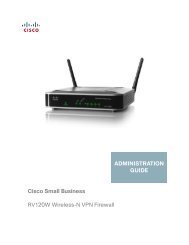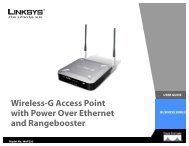Cisco Catalyst 6500 Supervisor 2T Architecture - Ipland
Cisco Catalyst 6500 Supervisor 2T Architecture - Ipland
Cisco Catalyst 6500 Supervisor 2T Architecture - Ipland
You also want an ePaper? Increase the reach of your titles
YUMPU automatically turns print PDFs into web optimized ePapers that Google loves.
White PaperFunctional AreaFeatureUp to 16 path lookup for uRPFNetFlow ServicesEgress NetFlowIncreased NetFlow table size to 512 K (non XL) or 1 M (XL)Improved NetFlow hashFlexible NetFlow and NetFlow v9 support in hardwareHardware-sampled NetFlowQuality of Service (QoS)Per-port -per-VLAN policiesDistributed policing (up to 4 K policers)Increased scalability for aggregate policing (up to 16 K policers) and microflow policing (up to 128 policers)Increased number of flow masks to reduce feature incompatibilitiesEgress microflow policingIncrease in DSCP mutation mapsPacket or byte-based policingVirtualizationLayer 2 over GREMPLS aggregate labels increased up to 16 KNative H-VPLSMPLS over GRE16 K EoMPLS tunnelsThe following sections provide a brief overview of each of the enhancements noted in the above table, divided intoLayer 2 and Layer 3 functional groups.Layer 2 - Increased MAC Address SupportA 128 K MAC address table is standard on both models of the PFC4. The MAC address table has been enhanced tosupport additional fields in a MAC address table entry, such as the bridge domain (BD) that the MAC address is apart of.Layer 2 - Bridge DomainsThe bridge domain is a new concept that has been introduced with PFC4. A bridge domain is used to help scaletraditional VLANs, as well as to scale internal Layer 2 forwarding within the switch. Bridge domains are mapped toeach VLAN that a user configures, as well as other resources such as an EoMPLS/VPLS tunnel, L3 sub-interfaces,and multicast Egress replication-mode. In essence, a bridge domain is equal to a VLAN (which is a 12-bit ID,allowing 4096 unique values). Bridge domains use a 14 bit ID (12 bits are VLAN ID), for a total of 16 K bridgedomains supported in hardware by the PFC4.Layer 2 - Increased Logical interfacesThe PFC4 introduces the concept of a Logical Interface (LIF), which is a hardware-independent interface (or port)reference index associated with all frames entering the forwarding engine. A LIF is a 72-bit internal addresscomprised of the bridge domain (BD), the source port index and other associated information (for example, protocoltype) used by the PFC4 to facilitate forwarding decisions. This allows Layer 2 forwarding characteristics to belogically separated from Layer 3 characteristics. The PFC4 adds hardware support for up to 128 K LIFs.Layer 2 - Improved EtherChannel HashSkew tables have been introduced to overcome issues with distributing traffic over an odd number of links (3, 5, 6,and 7) that form part of an EtherChannel link bundle. Previous PFC3x engines offered balanced distribution acrosseven numbered link (2, 4, and 8) bundles. However, link bundles with 3, 5, 6, or 7 member ports could end up withuneven distribution. The use of skew tables, as part of the processing logic for selecting a link in a bundle, helpsalleviate those earlier problems.© 2011-2012 <strong>Cisco</strong> and/or its affiliates. All rights reserved. This document is <strong>Cisco</strong> Partner Confidential Information. Page 18 of 46
















